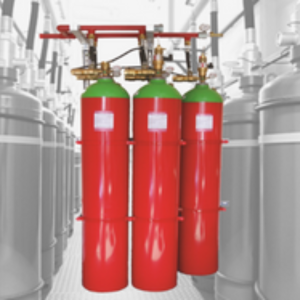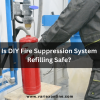![]()
Fire Immuniser
+91-7829629111
Email: info@variex.in
Varistor Technologies Pvt. Ltd.
Block-1, First Floor, Ardente Office One, Hoodi Circle, ITPL Main Road, Bengaluru, Karnataka 560048, IN
Types Of Fire Suppression Systems
Fire suppression systems play a critical role in safeguarding lives and property by swiftly controlling or extinguishing fires. With diverse environments and fire hazards, various types of fire suppression systems have been developed to address specific needs. This comprehensive guide delves deeper into the different types of fire suppression systems and their applications.
Water-Based Fire Suppression Systems:
- Wet Pipe Sprinkler Systems: Utilizing water as the extinguishing agent, wet pipe sprinkler systems feature pipes filled with pressurized water connected to sprinkler heads. These heads are activated by heat, releasing water directly onto the fire. Commonly found in residential, commercial, and industrial settings, wet pipe systems are reliable and effective for a wide range of fire hazards.
- Deluge Systems: Deluge systems are designed for high-hazard environments where rapid fire spread is a concern. Unlike traditional sprinkler systems, deluge systems employ open sprinkler heads that discharge water simultaneously upon detection of fire or manual activation. They are commonly used in facilities with highly flammable materials, such as chemical plants and power stations.
- Pre-action Systems: Pre-action systems incorporate elements of both wet and dry pipe systems. Water is held back by a valve until a fire detection system signals the need for suppression. Once activated, water flows into the pipes and is discharged through sprinklers. Pre-action systems are ideal for areas where accidental water discharge could cause significant damage, such as data centers, museums, and libraries.
Gaseous Fire Suppression Systems:
- Clean Agent Systems: Clean agent fire suppression systems utilize inert gases or chemical agents to extinguish fires without leaving residue or causing damage to sensitive equipment. These systems are commonly used in environments where water-based suppression is impractical or harmful, such as server rooms, telecommunications facilities, and archives.
- Carbon Dioxide (CO2) Systems: CO2 suppression systems rapidly displace oxygen, effectively smothering fires. They are particularly well-suited for extinguishing fires involving flammable liquids and electrical equipment. However, CO2 systems require careful design and ventilation to ensure the safety of occupants and prevent asphyxiation risks.
Foam-Based Fire Suppression Systems:
- Foam Sprinkler Systems: Foam sprinkler systems combine water with foam concentrate to create a blanket of foam that suppresses fires by cooling and smothering them. These systems are commonly used in areas with flammable liquids, such as aircraft hangars, fuel storage facilities, and chemical processing plants.
- High-Expansion Foam Systems: High-expansion foam systems produce large volumes of foam, which expands to fill enclosed spaces rapidly. They are effective for suppressing fires in confined areas such as basements, tunnels, and underground parking garages.
Dry Chemical Fire Suppression Systems:
- Dry Chemical Systems: Dry chemical fire suppression systems utilize powdered extinguishing agents, such as ABC powder or potassium bicarbonate, to interrupt the chemical reaction of combustion. These systems are versatile and effective for combating Class A, B, and C fires, making them suitable for a wide range of applications, including commercial kitchens, manufacturing facilities, and paint booths.
Conclusion:
Understanding the different types of fire suppression systems is essential for selecting the most appropriate solution to mitigate fire risks effectively. By considering factors such as fire hazards, occupancy types, and environmental conditions, stakeholders can implement reliable and efficient fire protection measures tailored to their specific needs. Regular maintenance, inspection, and testing are critical to ensuring the continued effectiveness and reliability of fire suppression systems in emergency situations.
Frequently Asked Questions
What is a fire suppression system?
- A fire suppression system is a collection of devices and equipment designed to detect, control, and extinguish fires automatically. These systems are essential for protecting lives and property by rapidly responding to fires and preventing their spread.
Why are fire suppression systems important?
- Fire suppression systems are important because they can mitigate the devastating effects of fires by quickly extinguishing them or controlling their spread until firefighters arrive. They help minimize property damage, prevent injuries, and save lives.
What are the different types of fire suppression systems?
- There are several types of fire suppression systems, including:
- Water-Based Systems (e.g., wet pipe sprinkler, deluge, pre-action)
- Gaseous Systems (e.g., clean agent, carbon dioxide)
- Foam-Based Systems (e.g., foam sprinkler, high-expansion foam)
- Dry Chemical Systems
- There are several types of fire suppression systems, including:
How do fire suppression systems work?
- The operation of fire suppression systems varies depending on the type. Water-based systems use water to extinguish fires, while gaseous systems displace oxygen or interfere with the combustion process. Foam-based systems create a blanket of foam to smother fires, and dry chemical systems interrupt the chemical reaction of combustion.
Where are fire suppression systems commonly used?
- Fire suppression systems are commonly used in various settings, including:
- Commercial buildings
- Industrial facilities
- Residential properties
- Healthcare facilities
- Data centers
- Server rooms
- Laboratories
- Aircraft hangars
- Oil refineries
- Chemical plants
- Fire suppression systems are commonly used in various settings, including:
How often should fire suppression systems be inspected and maintained?
- Fire suppression systems should be inspected and maintained regularly to ensure they are in proper working condition. The frequency of inspections and maintenance varies depending on local regulations, manufacturer recommendations, and the specific type of system. Typically, inspections are conducted annually, with more comprehensive tests performed every few years.
Are fire suppression systems environmentally friendly?
- Many modern fire suppression systems are designed to be environmentally friendly by using agents that have minimal impact on the ozone layer and produce fewer greenhouse gas emissions. However, it's essential to select the appropriate system and agents based on environmental considerations and regulatory requirements.
Can fire suppression systems cause damage to property?
- While fire suppression systems are intended to minimize property damage by extinguishing fires quickly, they can sometimes cause water damage or chemical residue depending on the type of system and the nature of the fire. Proper design, installation, and maintenance are essential to mitigate potential damage and ensure effective fire protection.
Are fire suppression systems required by law?
- The requirements for fire suppression systems vary depending on local building codes, regulations, and industry standards. In many jurisdictions, certain types of buildings and occupancies are required to have fire suppression systems installed to comply with safety regulations and codes.
How can I choose the right fire suppression system for my property?
- Choosing the right fire suppression system involves assessing the specific fire hazards, occupancy type, environmental considerations, and budgetary constraints. Consulting with fire protection experts, engineers, and fire safety professionals can help determine the most appropriate system for your property's needs.
Final Say
We at VariEx.in or Variexonline.com have mastered the art of designing, installing, inspecting, and fixing automatic sprinkler systems with the help of our in-house team, which is capable of delivering the fire sprinkler services you need, whether large or small and at affordable cost.
To schedule a fire sprinkler installation, or you think our services could benefit your commercial property, contact us online or give us a call at, 7829629111










